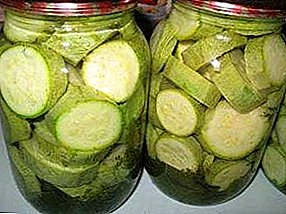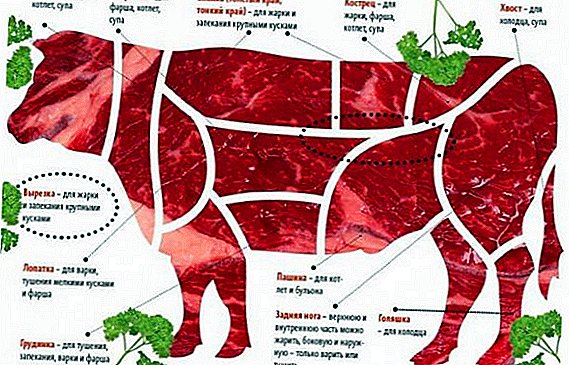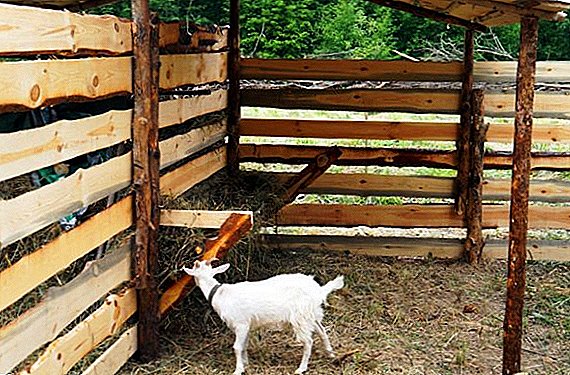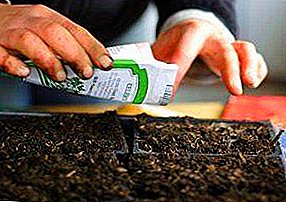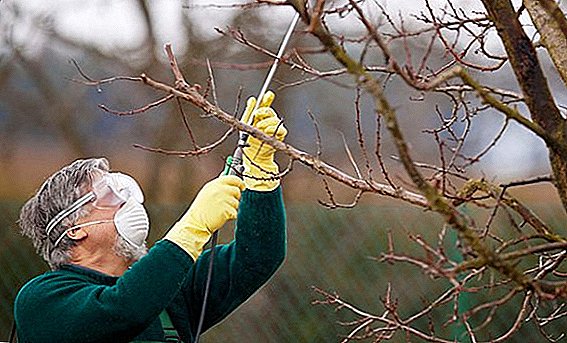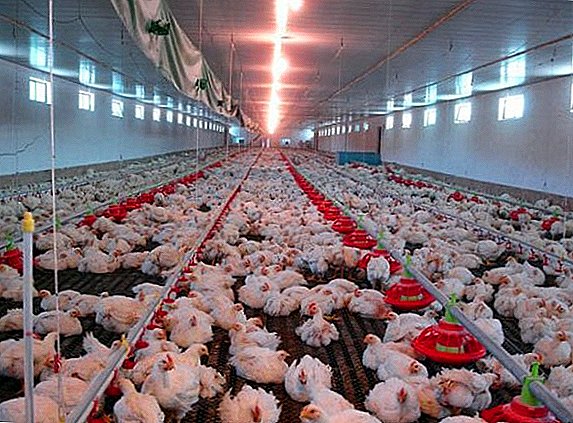 Chickens are valued by many farmers for their unpretentious conditions. However, if you want to get the maximum egg production from them, then you still have to think about organizing the most acceptable conditions for their life. In our article we will consider the possibility of floor keeping of birds, the features of organizing the regime of chickens and the preparation of the room itself.
Chickens are valued by many farmers for their unpretentious conditions. However, if you want to get the maximum egg production from them, then you still have to think about organizing the most acceptable conditions for their life. In our article we will consider the possibility of floor keeping of birds, the features of organizing the regime of chickens and the preparation of the room itself.
Types of chickens
Even indoors there are several common types of poultry housing: for example, if there is additional space outside the coop, you can equip the paddock, and if there is no such possibility, a deep litter is suitable inside the room. We will understand the most popular options more closely. 
Walking
This is ideal for those farmers who keep a small amount of chickens. In the hen house, it is very easy to build nests and perches for egg laying, and a small enclosed area on the sunny side of the building would be a great place for walking layers. The floor in such poultry houses can be both concrete and earthen, but in the wall it is necessary to arrange a manhole to the street.
Important! In winter, laying hens practically do not come out of the house, and walking is appropriate only when the outdoor temperature is at a level above -15 ° C. The density of placement in the room increases in cold weather.
Of course, the outdoor area must also be properly equipped - fenced with a two-meter fence, and if chickens are prone to flying, it is advisable to pull the grid on top. On the one hand walking it is necessary to make a shady area and place in it some more boxes for egg-laying. The size of the territory of walking should occupy about half the area of the chicken coop itself, and, like in the house, they install drinking bowls and containers with sand or ash so that the birds can clean their feathers.  With a free-range poultry for these purposes, a garden or a berry fits, but it’s better not to let the birds into the garden, especially after planting vegetables - they all eat it.
With a free-range poultry for these purposes, a garden or a berry fits, but it’s better not to let the birds into the garden, especially after planting vegetables - they all eat it.
Fugitive
A no-vigilance system is an outdoor content without walking on non-replaceable bedding or content in cells.
This kind of laying hens can not be called humane, as the bird is not only limited in movement in open areas, but is often kept in cages during the entire period of egg production. Of course, care for her in this case is significantly simplified, and the feed is spent less, but the period of productivity of such chickens will also be reduced. In addition, in birds, immunity to various diseases is reduced, they quickly gain weight and can suffer from paw diseases associated with insufficient activity.  Cell battery SOI For 20 heads of chickens you can make a kind of battery from the cells, divided into four sections. In each of them will be 5 chickens. The optimal width of this design is 183 cm, depth - 63 cm, height - 60 cm. The frame part can be made of a metallic angle, and the sides are covered with a net. Feeders should be installed in the front of each cage, and a gutter drinker at the top, along the entire length of the cell space.
Cell battery SOI For 20 heads of chickens you can make a kind of battery from the cells, divided into four sections. In each of them will be 5 chickens. The optimal width of this design is 183 cm, depth - 63 cm, height - 60 cm. The frame part can be made of a metallic angle, and the sides are covered with a net. Feeders should be installed in the front of each cage, and a gutter drinker at the top, along the entire length of the cell space.
Some farmers make the floor a little flat in the front, so that all the eggs that have been laid will roll in the right direction. The pallets installed under the cages will help to solve the problem with droppings, and if several tiers with cages are provided, they are placed on the roof of the lower cages.
Read also about the independent production of cages for poultry, in particular, for broilers.
Of course, from the point of view of humanity, this version of the content is the most inappropriate, but in large farms it is practiced more often than other ways of laying hens.
On deep bedding
Typically, this method of keeping birds is characteristic of a free-swing system. The floor in the house is simply covered with litter (for example, straw, husk, sawdust, peat or leaves collected in the garden), which, after mixing with chicken manure, can form a loose surface.  The initial layer of bedding should be about 10 cm, and for the entire period of keeping about 8-10 kg per 1 chicken is consumed. When a dense crust is formed on the floor surface, the top layer is scraped off and replaced with a new one. Do not allow the development of pathogenic organisms in the litter.
The initial layer of bedding should be about 10 cm, and for the entire period of keeping about 8-10 kg per 1 chicken is consumed. When a dense crust is formed on the floor surface, the top layer is scraped off and replaced with a new one. Do not allow the development of pathogenic organisms in the litter.
The use of fermentation litter helps to improve the life of animals and facilitate human labor in the maintenance of premises.
On mesh floors
Arrangement of netting floors, as well as the previous version, refers to the non-boorish method of keeping laying hens. For the construction of such a base in the house, stands are installed, reaching a height of 50-70 cm. Then they are equipped with grid frames, the size of which is mainly 1-1.5x2 cm.  Alternatively, instead of a net covering, frames can be nailed wooden planochkiand in this case the floors will be called slatted floors. If the base of the floor in the hen house is already wooden, there is a sense of additional mounting of pallets for collecting litter - otherwise the boards may eventually rot.
Alternatively, instead of a net covering, frames can be nailed wooden planochkiand in this case the floors will be called slatted floors. If the base of the floor in the hen house is already wooden, there is a sense of additional mounting of pallets for collecting litter - otherwise the boards may eventually rot.
Did you know? In the matter of egg production, chickens differ somewhat from other birds, in particular, in that they can use other people's nests for egg-laying. For them, it does not matter where it is to be carried.
Advantages and disadvantages of this method
Outdoor keeping of chickens is, undoubtedly, a more humane solution when breeding hens, moreover, benefits relate:
- a more comfortable existence of birds due to the free movement of the aviary, which in turn reduces the likelihood of the development of various ailments of the musculoskeletal system;
- lack of need for arrangement of cells and ventilation system;
- free access to chickens at any time, which simplifies the care for them (thanks to the free space, the farmer is easier to clean or feed).
 Concerning deficiencies floor content, the main ones will be:
Concerning deficiencies floor content, the main ones will be:
- large area of the chicken coop and the associated costs for its heating and lighting;
- greater feed consumption (grain and other dry products are trampled into the litter);
- the possibility of manure eating by hens during irregular cleaning of the house;
- the need for large time and physical costs of poultry care;
- when keeping a large number of chickens in a limited area, the spread of infectious diseases is possible.
As you can see, the list of negative points somewhat exceeds the advantages of the floor-laying hens, but all of these drawbacks relate more to farms with hundreds and thousands of birds. When breeding hens for personal needs, especially if you are a beginner poultry farmer, an outdoor way of placing them with or without additional walking will be the best solution.
Tips for poultry farmers: how to choose a chicken coop when buying, self-produce and equip a poultry house; how to make ventilation, heating, lighting; disinfect.
Feeding and watering with outdoor placement of chickens
The described bird placement option provides at least a 10-centimeter space for feeding each hen and 2.5 free centimeters for access to the water bowl. In addition, chicken bowls should be made so that the food is not scattered and not trampled by birds in the litter, and the litter from the floor does not fall into the trough.  For these purposes, the usual wooden boxes size 110x25 cm. The minimum height of the side is 13 cm, that is, when the hen will peck off the feed, the side of the feed tank must be at the level of its back. When organizing two-way access to the feeders, it is possible to feed 20-25 individuals at the same time, but it is impossible to completely fill the tank, otherwise the birds simply scatter the food (the optimal amount of feed filled is 1/3 of the total capacity of the feeder).
For these purposes, the usual wooden boxes size 110x25 cm. The minimum height of the side is 13 cm, that is, when the hen will peck off the feed, the side of the feed tank must be at the level of its back. When organizing two-way access to the feeders, it is possible to feed 20-25 individuals at the same time, but it is impossible to completely fill the tank, otherwise the birds simply scatter the food (the optimal amount of feed filled is 1/3 of the total capacity of the feeder).
Important! Any chickens need mineral feed, so it’s worth preparing a separate place for them. In such a box is usually placed limestone, gravel or chalk.
For the green fit special, V-shaped feeder with mesh as the front wall. You can place it on the wall, but so that chickens can freely reach the grass.  V-shaped green feeder As for the drinkers, a variety of containers are used here, although you can also use the option gutterconnected to the water supply system. Protect the litter from moisture by using a tin tray installed at the watering site.
V-shaped green feeder As for the drinkers, a variety of containers are used here, although you can also use the option gutterconnected to the water supply system. Protect the litter from moisture by using a tin tray installed at the watering site.
Read also about the independent production of feeders and drinkers for chickens, in particular, feeders and drinkers for broilers.
How to equip roost and nests
None of the coop will not be complete without rodents and nests, especially when it comes to layers. On average, one chicken should be about 18-20 cm perchmade of wooden timber with a cross section of 5x5 cm. From the top it can be slightly rounded, which will provide a more comfortable fit for the bird. Such bars are mainly placed along the walls in a horizontal direction with preservation of 60 cm from the floor.
In some cases, poultry farmers organize perches in the form of horizontally placed lines with a distance of 30–35 cm between adjacent crossbars. Installation is carried out so that, if necessary, the structure can be easily raised.  The number of nests should be calculated taking into account the number of chickens in the house. At one such place can have no more than five layers. Nests are made of wooden boxes measuring 35x35 cm and placed at a distance of 50 cm from the floor. Sawdust, straw or any other soft material are used as a filler for boxes, and a take-off plate can be installed in their front part.
The number of nests should be calculated taking into account the number of chickens in the house. At one such place can have no more than five layers. Nests are made of wooden boxes measuring 35x35 cm and placed at a distance of 50 cm from the floor. Sawdust, straw or any other soft material are used as a filler for boxes, and a take-off plate can be installed in their front part.
Learn more about the manufacture and placement of perches and nests for laying hens.
How to produce walking
If you have the opportunity to equip the paddock - it is worth it. As we mentioned earlier, his place can be a grid fenced around the perimeter or absolutely free, that is, chickens will walk throughout the territory accessible to them. It is easy to run a bird walk: with the first morning rays, you just need to open the door in the hen house wall, and your charges will go out into the yard.
In the evening, the bird is either driven back to the barn, or it is waited until all the hens themselves go to roost, after which it remains only to lock the door.
The main parameters of the floor content of chickens
You can achieve good performance from the hens only if the bird is comfortable in the hen house. With outdoor content the density of livestock is 4 hens per 1 square. m, and when organizing the roost it is worth remembering that all the wards should be placed on them, and even with the remaining space between the neighbors (approximately 10 cm). For free access of the bird to the roost, intermediate sticks or staves should be provided. 
Floor content in industrial conditions
In the conditions of large domestic poultry farms, floor keeping of laying hens is practiced extremely rarely, since the installation of cages will be a more advantageous accommodation option (from an economic point of view). "On the floor" may be kept unless breeding chickens, which reduces the possibility of injury and increases the weight gain of the males of the parent herd. In addition, the floor content in this case reduces the likelihood of problems with the fertilization of eggs, however, the density of planting should be lower than in industrial conditions.
At reproductive factories, chicks are first planted in separate poultry houses for young stock, and then transferred to adult henhouses with a floor watering system, an automatic feed distribution system and forced-air ventilation. Also on an industrial scale gas heating and a microclimate control system are often equipped. Eggs from nests in such poultry houses roll out onto the egg belt, and then get into the conveyor. Only a small number of testicles people collect manually.
Did you know? Chickens are able to become attached to a person and recognize in him a master as well as cats or dogs. If possible, they will even accompany him throughout the yard, especially if they were close to the poultry farmer since hatching.
Video: floor broiler experience
Outdoor content with the possibility of laying hens will be a great way to get tasty, and most importantly - natural eggs, so we recommend considering it.



